Guided Review of Nominated Literature: COPD Exacerbation Management
VerifiedAdded on 2021/06/16
|10
|2109
|51
Report
AI Summary
This report presents a guided review of nominated literature focusing on the self-management of Chronic Obstructive Pulmonary Disease (COPD) by patients to reduce hospital admissions. The study investigated how COPD patients assess and manage exacerbations at home, employing a qualitative grounded theory design. Forty-four participants, aged 55-85, with severe COPD, were included. Data collection involved semi-structured in-depth interviews, analyzed using NVIVO 10 and grounded theory methods, including constant comparative, axial, open, and selective coding. The findings identified visible and invisible symptoms used by patients to recognize exacerbations, and self-medication, recovery monitoring, and healthcare contact as management strategies. The report emphasizes the significance of the research in enhancing current clinical practices and educating newly diagnosed patients about assessing and managing COPD exacerbations, potentially leading to a more precise definition of COPD exacerbations.
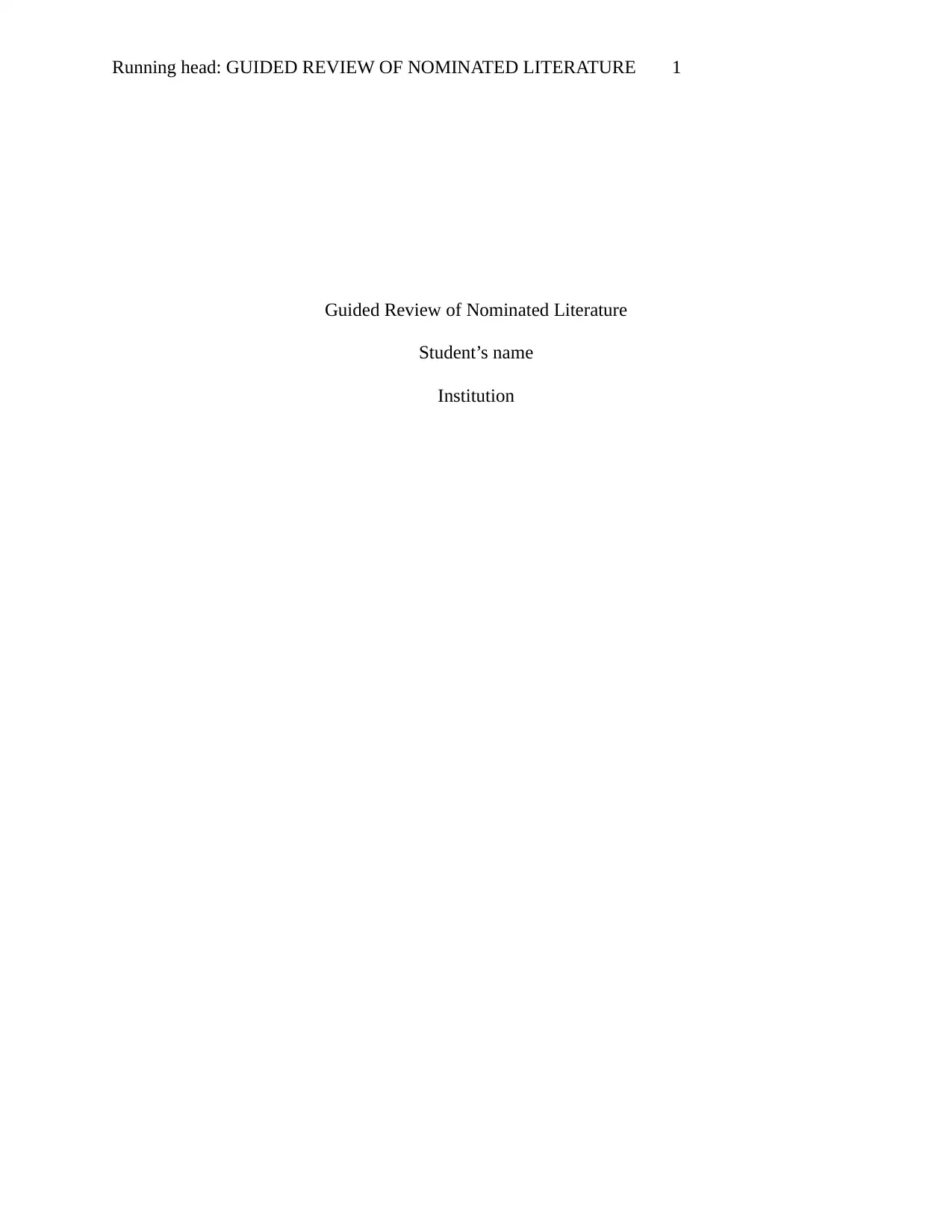
Running head: GUIDED REVIEW OF NOMINATED LITERATURE 1
Guided Review of Nominated Literature
Student’s name
Institution
Guided Review of Nominated Literature
Student’s name
Institution
Paraphrase This Document
Need a fresh take? Get an instant paraphrase of this document with our AI Paraphraser
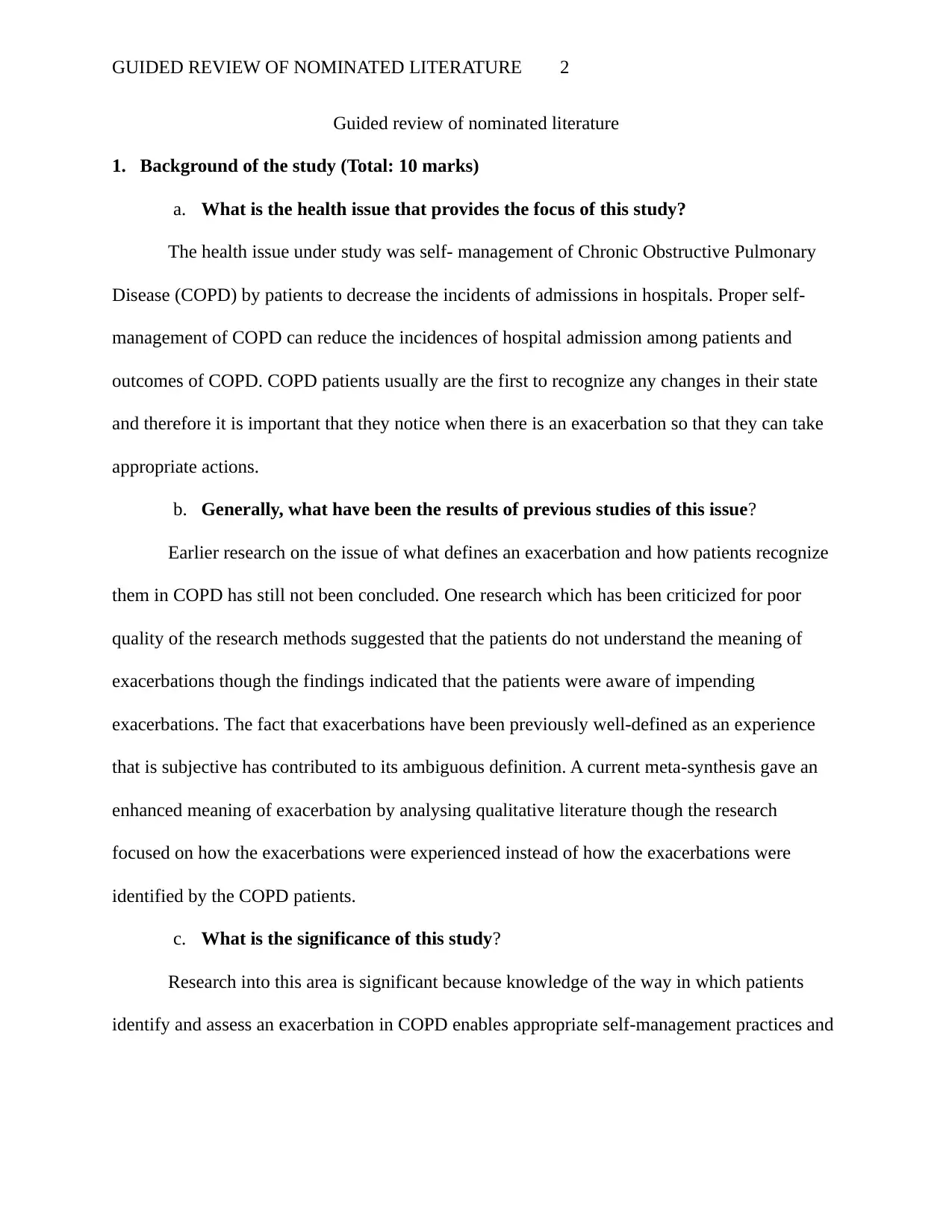
GUIDED REVIEW OF NOMINATED LITERATURE 2
Guided review of nominated literature
1. Background of the study (Total: 10 marks)
a. What is the health issue that provides the focus of this study?
The health issue under study was self- management of Chronic Obstructive Pulmonary
Disease (COPD) by patients to decrease the incidents of admissions in hospitals. Proper self-
management of COPD can reduce the incidences of hospital admission among patients and
outcomes of COPD. COPD patients usually are the first to recognize any changes in their state
and therefore it is important that they notice when there is an exacerbation so that they can take
appropriate actions.
b. Generally, what have been the results of previous studies of this issue?
Earlier research on the issue of what defines an exacerbation and how patients recognize
them in COPD has still not been concluded. One research which has been criticized for poor
quality of the research methods suggested that the patients do not understand the meaning of
exacerbations though the findings indicated that the patients were aware of impending
exacerbations. The fact that exacerbations have been previously well-defined as an experience
that is subjective has contributed to its ambiguous definition. A current meta-synthesis gave an
enhanced meaning of exacerbation by analysing qualitative literature though the research
focused on how the exacerbations were experienced instead of how the exacerbations were
identified by the COPD patients.
c. What is the significance of this study?
Research into this area is significant because knowledge of the way in which patients
identify and assess an exacerbation in COPD enables appropriate self-management practices and
Guided review of nominated literature
1. Background of the study (Total: 10 marks)
a. What is the health issue that provides the focus of this study?
The health issue under study was self- management of Chronic Obstructive Pulmonary
Disease (COPD) by patients to decrease the incidents of admissions in hospitals. Proper self-
management of COPD can reduce the incidences of hospital admission among patients and
outcomes of COPD. COPD patients usually are the first to recognize any changes in their state
and therefore it is important that they notice when there is an exacerbation so that they can take
appropriate actions.
b. Generally, what have been the results of previous studies of this issue?
Earlier research on the issue of what defines an exacerbation and how patients recognize
them in COPD has still not been concluded. One research which has been criticized for poor
quality of the research methods suggested that the patients do not understand the meaning of
exacerbations though the findings indicated that the patients were aware of impending
exacerbations. The fact that exacerbations have been previously well-defined as an experience
that is subjective has contributed to its ambiguous definition. A current meta-synthesis gave an
enhanced meaning of exacerbation by analysing qualitative literature though the research
focused on how the exacerbations were experienced instead of how the exacerbations were
identified by the COPD patients.
c. What is the significance of this study?
Research into this area is significant because knowledge of the way in which patients
identify and assess an exacerbation in COPD enables appropriate self-management practices and
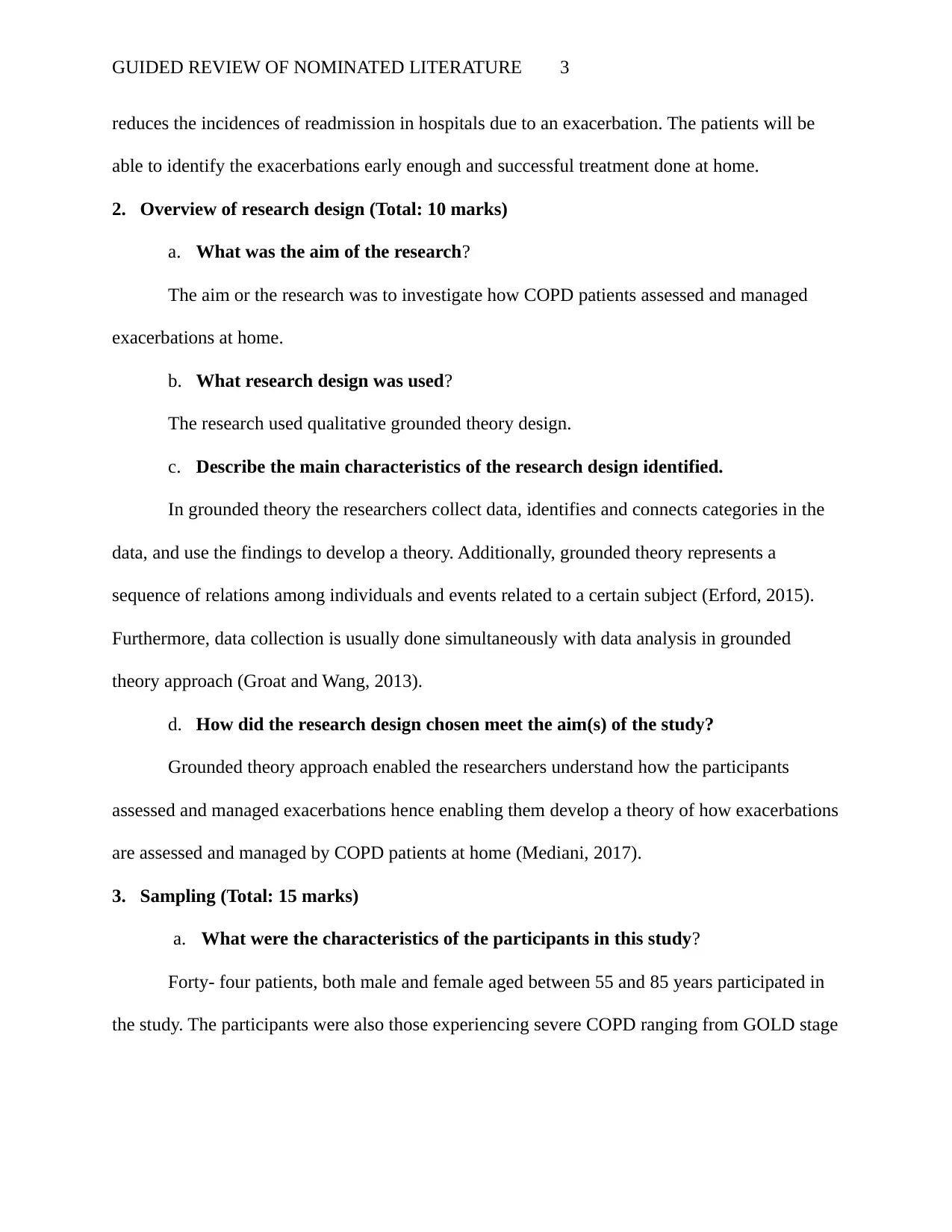
GUIDED REVIEW OF NOMINATED LITERATURE 3
reduces the incidences of readmission in hospitals due to an exacerbation. The patients will be
able to identify the exacerbations early enough and successful treatment done at home.
2. Overview of research design (Total: 10 marks)
a. What was the aim of the research?
The aim or the research was to investigate how COPD patients assessed and managed
exacerbations at home.
b. What research design was used?
The research used qualitative grounded theory design.
c. Describe the main characteristics of the research design identified.
In grounded theory the researchers collect data, identifies and connects categories in the
data, and use the findings to develop a theory. Additionally, grounded theory represents a
sequence of relations among individuals and events related to a certain subject (Erford, 2015).
Furthermore, data collection is usually done simultaneously with data analysis in grounded
theory approach (Groat and Wang, 2013).
d. How did the research design chosen meet the aim(s) of the study?
Grounded theory approach enabled the researchers understand how the participants
assessed and managed exacerbations hence enabling them develop a theory of how exacerbations
are assessed and managed by COPD patients at home (Mediani, 2017).
3. Sampling (Total: 15 marks)
a. What were the characteristics of the participants in this study?
Forty- four patients, both male and female aged between 55 and 85 years participated in
the study. The participants were also those experiencing severe COPD ranging from GOLD stage
reduces the incidences of readmission in hospitals due to an exacerbation. The patients will be
able to identify the exacerbations early enough and successful treatment done at home.
2. Overview of research design (Total: 10 marks)
a. What was the aim of the research?
The aim or the research was to investigate how COPD patients assessed and managed
exacerbations at home.
b. What research design was used?
The research used qualitative grounded theory design.
c. Describe the main characteristics of the research design identified.
In grounded theory the researchers collect data, identifies and connects categories in the
data, and use the findings to develop a theory. Additionally, grounded theory represents a
sequence of relations among individuals and events related to a certain subject (Erford, 2015).
Furthermore, data collection is usually done simultaneously with data analysis in grounded
theory approach (Groat and Wang, 2013).
d. How did the research design chosen meet the aim(s) of the study?
Grounded theory approach enabled the researchers understand how the participants
assessed and managed exacerbations hence enabling them develop a theory of how exacerbations
are assessed and managed by COPD patients at home (Mediani, 2017).
3. Sampling (Total: 15 marks)
a. What were the characteristics of the participants in this study?
Forty- four patients, both male and female aged between 55 and 85 years participated in
the study. The participants were also those experiencing severe COPD ranging from GOLD stage
⊘ This is a preview!⊘
Do you want full access?
Subscribe today to unlock all pages.

Trusted by 1+ million students worldwide
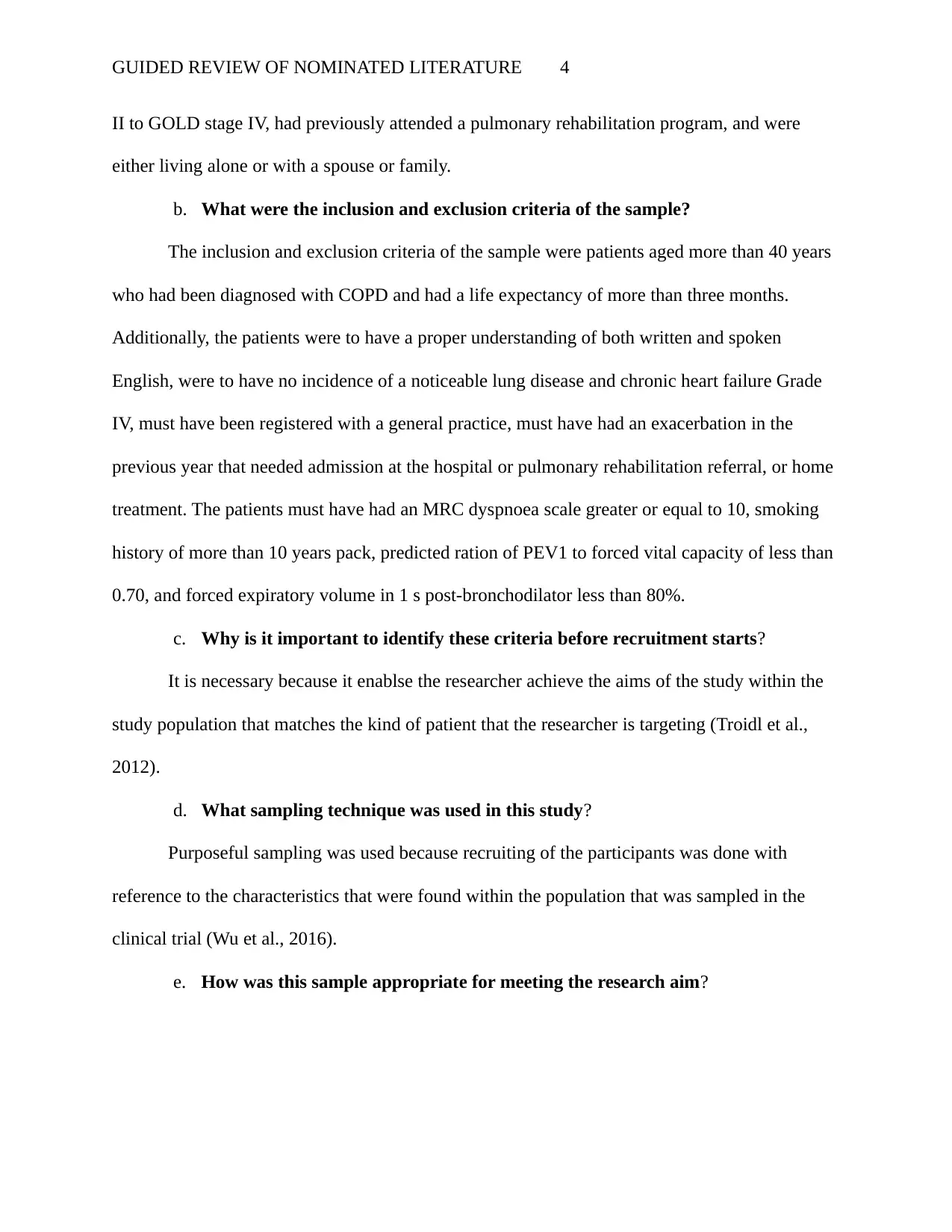
GUIDED REVIEW OF NOMINATED LITERATURE 4
II to GOLD stage IV, had previously attended a pulmonary rehabilitation program, and were
either living alone or with a spouse or family.
b. What were the inclusion and exclusion criteria of the sample?
The inclusion and exclusion criteria of the sample were patients aged more than 40 years
who had been diagnosed with COPD and had a life expectancy of more than three months.
Additionally, the patients were to have a proper understanding of both written and spoken
English, were to have no incidence of a noticeable lung disease and chronic heart failure Grade
IV, must have been registered with a general practice, must have had an exacerbation in the
previous year that needed admission at the hospital or pulmonary rehabilitation referral, or home
treatment. The patients must have had an MRC dyspnoea scale greater or equal to 10, smoking
history of more than 10 years pack, predicted ration of PEV1 to forced vital capacity of less than
0.70, and forced expiratory volume in 1 s post-bronchodilator less than 80%.
c. Why is it important to identify these criteria before recruitment starts?
It is necessary because it enablse the researcher achieve the aims of the study within the
study population that matches the kind of patient that the researcher is targeting (Troidl et al.,
2012).
d. What sampling technique was used in this study?
Purposeful sampling was used because recruiting of the participants was done with
reference to the characteristics that were found within the population that was sampled in the
clinical trial (Wu et al., 2016).
e. How was this sample appropriate for meeting the research aim?
II to GOLD stage IV, had previously attended a pulmonary rehabilitation program, and were
either living alone or with a spouse or family.
b. What were the inclusion and exclusion criteria of the sample?
The inclusion and exclusion criteria of the sample were patients aged more than 40 years
who had been diagnosed with COPD and had a life expectancy of more than three months.
Additionally, the patients were to have a proper understanding of both written and spoken
English, were to have no incidence of a noticeable lung disease and chronic heart failure Grade
IV, must have been registered with a general practice, must have had an exacerbation in the
previous year that needed admission at the hospital or pulmonary rehabilitation referral, or home
treatment. The patients must have had an MRC dyspnoea scale greater or equal to 10, smoking
history of more than 10 years pack, predicted ration of PEV1 to forced vital capacity of less than
0.70, and forced expiratory volume in 1 s post-bronchodilator less than 80%.
c. Why is it important to identify these criteria before recruitment starts?
It is necessary because it enablse the researcher achieve the aims of the study within the
study population that matches the kind of patient that the researcher is targeting (Troidl et al.,
2012).
d. What sampling technique was used in this study?
Purposeful sampling was used because recruiting of the participants was done with
reference to the characteristics that were found within the population that was sampled in the
clinical trial (Wu et al., 2016).
e. How was this sample appropriate for meeting the research aim?
Paraphrase This Document
Need a fresh take? Get an instant paraphrase of this document with our AI Paraphraser
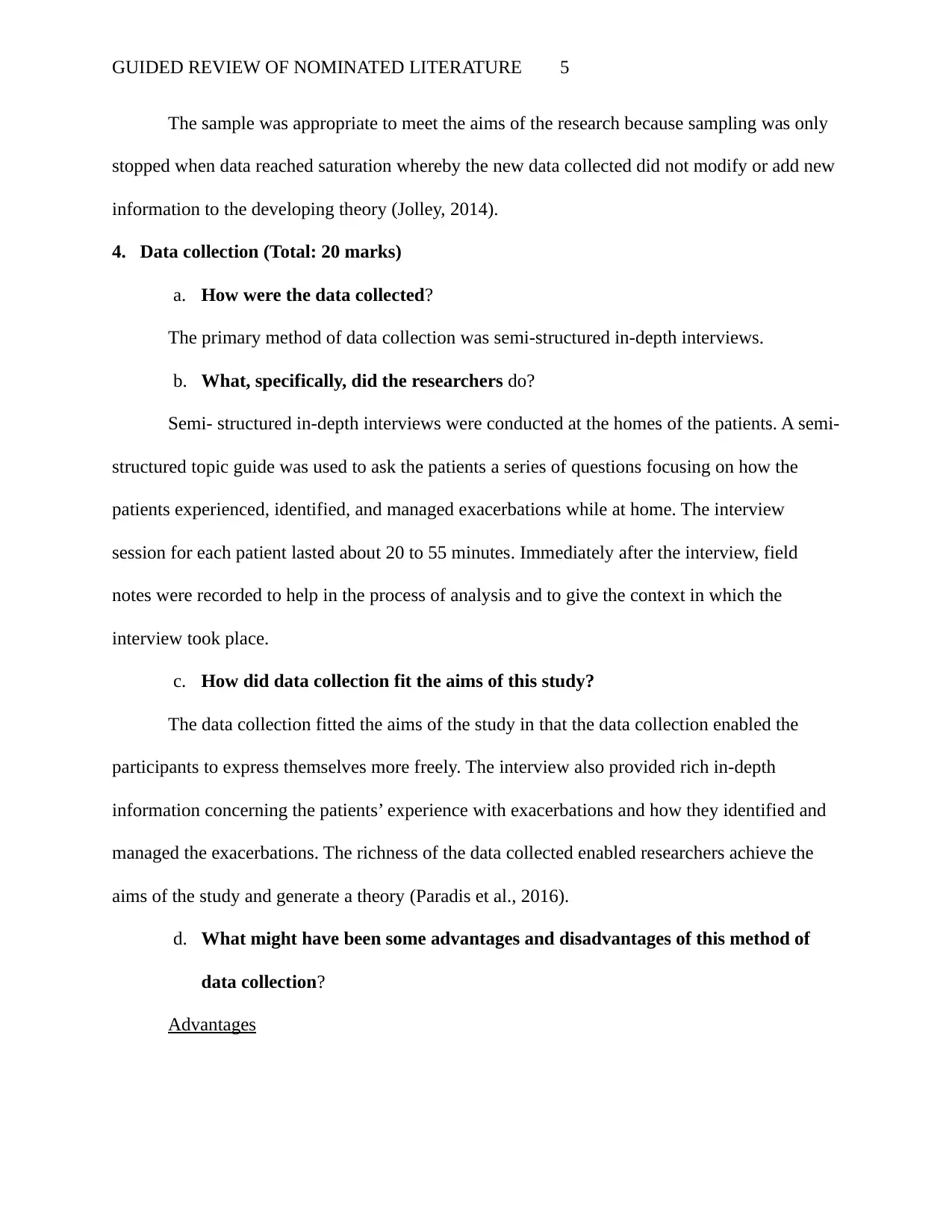
GUIDED REVIEW OF NOMINATED LITERATURE 5
The sample was appropriate to meet the aims of the research because sampling was only
stopped when data reached saturation whereby the new data collected did not modify or add new
information to the developing theory (Jolley, 2014).
4. Data collection (Total: 20 marks)
a. How were the data collected?
The primary method of data collection was semi-structured in-depth interviews.
b. What, specifically, did the researchers do?
Semi- structured in-depth interviews were conducted at the homes of the patients. A semi-
structured topic guide was used to ask the patients a series of questions focusing on how the
patients experienced, identified, and managed exacerbations while at home. The interview
session for each patient lasted about 20 to 55 minutes. Immediately after the interview, field
notes were recorded to help in the process of analysis and to give the context in which the
interview took place.
c. How did data collection fit the aims of this study?
The data collection fitted the aims of the study in that the data collection enabled the
participants to express themselves more freely. The interview also provided rich in-depth
information concerning the patients’ experience with exacerbations and how they identified and
managed the exacerbations. The richness of the data collected enabled researchers achieve the
aims of the study and generate a theory (Paradis et al., 2016).
d. What might have been some advantages and disadvantages of this method of
data collection?
Advantages
The sample was appropriate to meet the aims of the research because sampling was only
stopped when data reached saturation whereby the new data collected did not modify or add new
information to the developing theory (Jolley, 2014).
4. Data collection (Total: 20 marks)
a. How were the data collected?
The primary method of data collection was semi-structured in-depth interviews.
b. What, specifically, did the researchers do?
Semi- structured in-depth interviews were conducted at the homes of the patients. A semi-
structured topic guide was used to ask the patients a series of questions focusing on how the
patients experienced, identified, and managed exacerbations while at home. The interview
session for each patient lasted about 20 to 55 minutes. Immediately after the interview, field
notes were recorded to help in the process of analysis and to give the context in which the
interview took place.
c. How did data collection fit the aims of this study?
The data collection fitted the aims of the study in that the data collection enabled the
participants to express themselves more freely. The interview also provided rich in-depth
information concerning the patients’ experience with exacerbations and how they identified and
managed the exacerbations. The richness of the data collected enabled researchers achieve the
aims of the study and generate a theory (Paradis et al., 2016).
d. What might have been some advantages and disadvantages of this method of
data collection?
Advantages
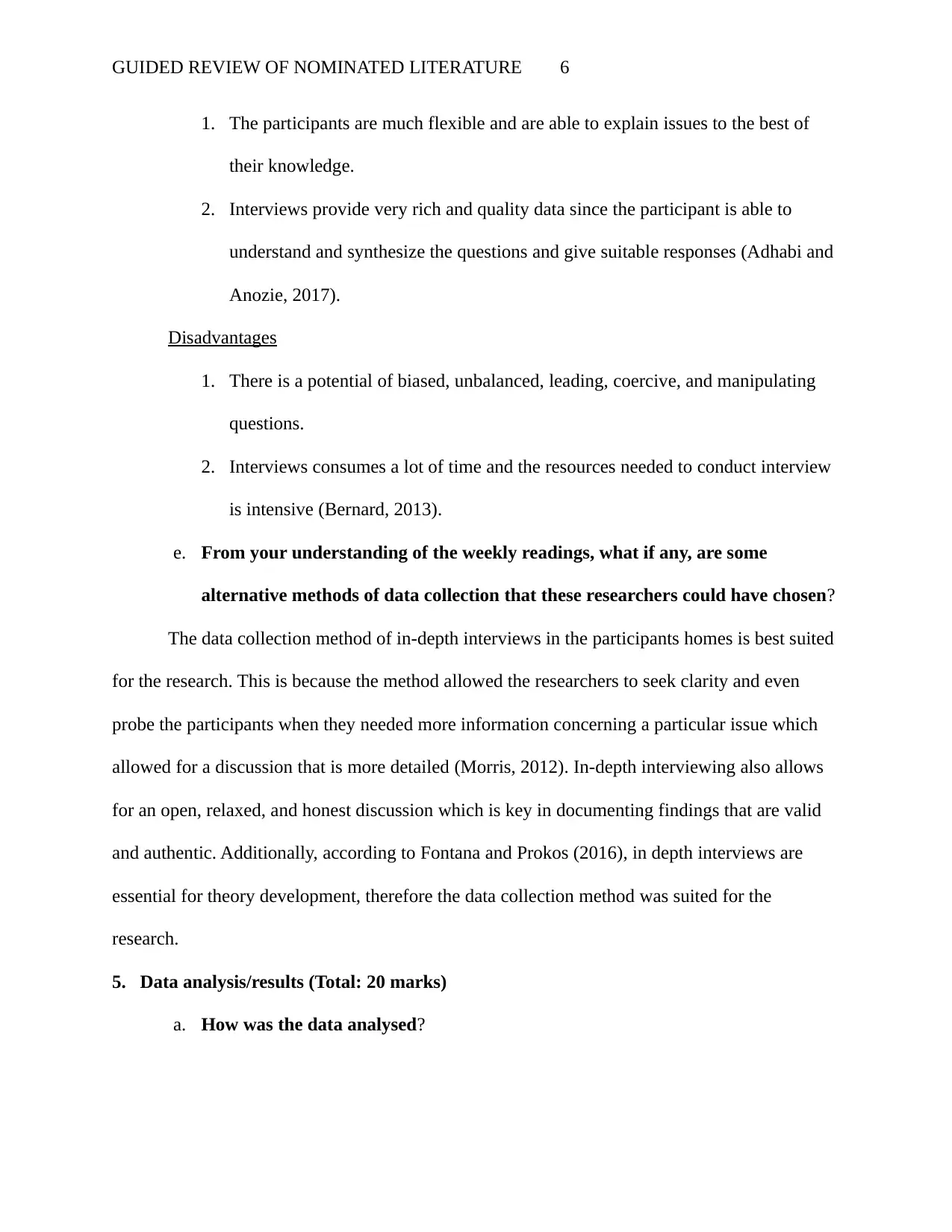
GUIDED REVIEW OF NOMINATED LITERATURE 6
1. The participants are much flexible and are able to explain issues to the best of
their knowledge.
2. Interviews provide very rich and quality data since the participant is able to
understand and synthesize the questions and give suitable responses (Adhabi and
Anozie, 2017).
Disadvantages
1. There is a potential of biased, unbalanced, leading, coercive, and manipulating
questions.
2. Interviews consumes a lot of time and the resources needed to conduct interview
is intensive (Bernard, 2013).
e. From your understanding of the weekly readings, what if any, are some
alternative methods of data collection that these researchers could have chosen?
The data collection method of in-depth interviews in the participants homes is best suited
for the research. This is because the method allowed the researchers to seek clarity and even
probe the participants when they needed more information concerning a particular issue which
allowed for a discussion that is more detailed (Morris, 2012). In-depth interviewing also allows
for an open, relaxed, and honest discussion which is key in documenting findings that are valid
and authentic. Additionally, according to Fontana and Prokos (2016), in depth interviews are
essential for theory development, therefore the data collection method was suited for the
research.
5. Data analysis/results (Total: 20 marks)
a. How was the data analysed?
1. The participants are much flexible and are able to explain issues to the best of
their knowledge.
2. Interviews provide very rich and quality data since the participant is able to
understand and synthesize the questions and give suitable responses (Adhabi and
Anozie, 2017).
Disadvantages
1. There is a potential of biased, unbalanced, leading, coercive, and manipulating
questions.
2. Interviews consumes a lot of time and the resources needed to conduct interview
is intensive (Bernard, 2013).
e. From your understanding of the weekly readings, what if any, are some
alternative methods of data collection that these researchers could have chosen?
The data collection method of in-depth interviews in the participants homes is best suited
for the research. This is because the method allowed the researchers to seek clarity and even
probe the participants when they needed more information concerning a particular issue which
allowed for a discussion that is more detailed (Morris, 2012). In-depth interviewing also allows
for an open, relaxed, and honest discussion which is key in documenting findings that are valid
and authentic. Additionally, according to Fontana and Prokos (2016), in depth interviews are
essential for theory development, therefore the data collection method was suited for the
research.
5. Data analysis/results (Total: 20 marks)
a. How was the data analysed?
⊘ This is a preview!⊘
Do you want full access?
Subscribe today to unlock all pages.

Trusted by 1+ million students worldwide
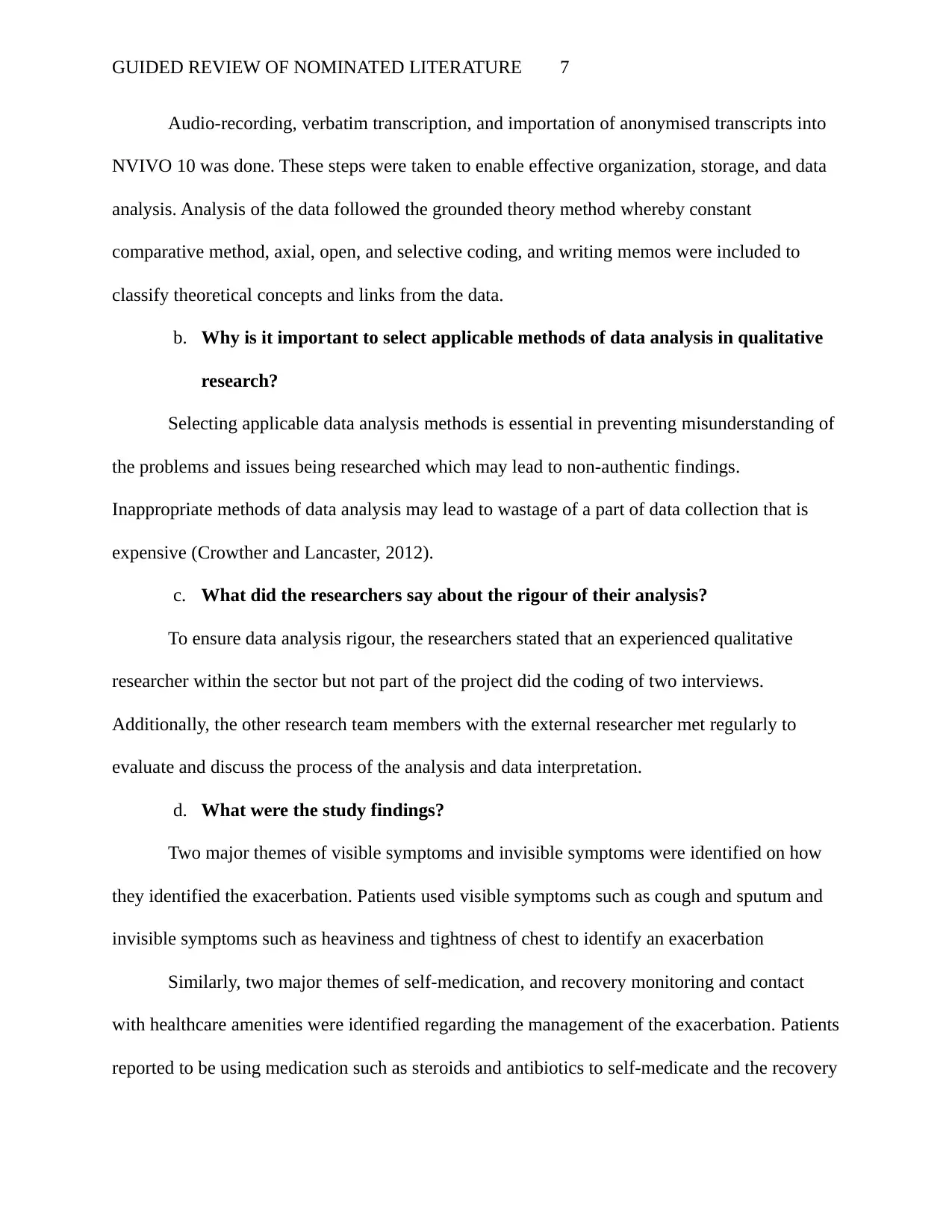
GUIDED REVIEW OF NOMINATED LITERATURE 7
Audio-recording, verbatim transcription, and importation of anonymised transcripts into
NVIVO 10 was done. These steps were taken to enable effective organization, storage, and data
analysis. Analysis of the data followed the grounded theory method whereby constant
comparative method, axial, open, and selective coding, and writing memos were included to
classify theoretical concepts and links from the data.
b. Why is it important to select applicable methods of data analysis in qualitative
research?
Selecting applicable data analysis methods is essential in preventing misunderstanding of
the problems and issues being researched which may lead to non-authentic findings.
Inappropriate methods of data analysis may lead to wastage of a part of data collection that is
expensive (Crowther and Lancaster, 2012).
c. What did the researchers say about the rigour of their analysis?
To ensure data analysis rigour, the researchers stated that an experienced qualitative
researcher within the sector but not part of the project did the coding of two interviews.
Additionally, the other research team members with the external researcher met regularly to
evaluate and discuss the process of the analysis and data interpretation.
d. What were the study findings?
Two major themes of visible symptoms and invisible symptoms were identified on how
they identified the exacerbation. Patients used visible symptoms such as cough and sputum and
invisible symptoms such as heaviness and tightness of chest to identify an exacerbation
Similarly, two major themes of self-medication, and recovery monitoring and contact
with healthcare amenities were identified regarding the management of the exacerbation. Patients
reported to be using medication such as steroids and antibiotics to self-medicate and the recovery
Audio-recording, verbatim transcription, and importation of anonymised transcripts into
NVIVO 10 was done. These steps were taken to enable effective organization, storage, and data
analysis. Analysis of the data followed the grounded theory method whereby constant
comparative method, axial, open, and selective coding, and writing memos were included to
classify theoretical concepts and links from the data.
b. Why is it important to select applicable methods of data analysis in qualitative
research?
Selecting applicable data analysis methods is essential in preventing misunderstanding of
the problems and issues being researched which may lead to non-authentic findings.
Inappropriate methods of data analysis may lead to wastage of a part of data collection that is
expensive (Crowther and Lancaster, 2012).
c. What did the researchers say about the rigour of their analysis?
To ensure data analysis rigour, the researchers stated that an experienced qualitative
researcher within the sector but not part of the project did the coding of two interviews.
Additionally, the other research team members with the external researcher met regularly to
evaluate and discuss the process of the analysis and data interpretation.
d. What were the study findings?
Two major themes of visible symptoms and invisible symptoms were identified on how
they identified the exacerbation. Patients used visible symptoms such as cough and sputum and
invisible symptoms such as heaviness and tightness of chest to identify an exacerbation
Similarly, two major themes of self-medication, and recovery monitoring and contact
with healthcare amenities were identified regarding the management of the exacerbation. Patients
reported to be using medication such as steroids and antibiotics to self-medicate and the recovery
Paraphrase This Document
Need a fresh take? Get an instant paraphrase of this document with our AI Paraphraser
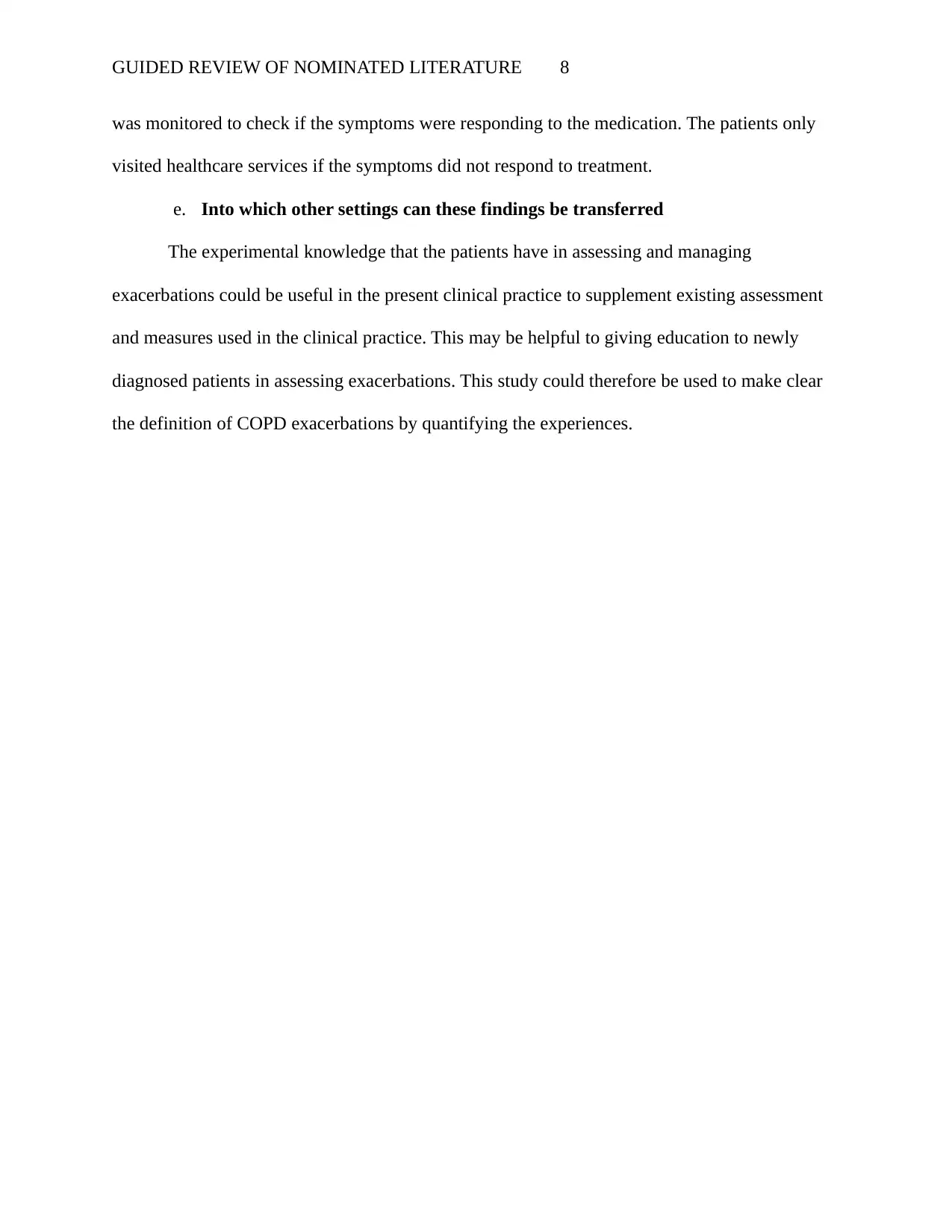
GUIDED REVIEW OF NOMINATED LITERATURE 8
was monitored to check if the symptoms were responding to the medication. The patients only
visited healthcare services if the symptoms did not respond to treatment.
e. Into which other settings can these findings be transferred
The experimental knowledge that the patients have in assessing and managing
exacerbations could be useful in the present clinical practice to supplement existing assessment
and measures used in the clinical practice. This may be helpful to giving education to newly
diagnosed patients in assessing exacerbations. This study could therefore be used to make clear
the definition of COPD exacerbations by quantifying the experiences.
was monitored to check if the symptoms were responding to the medication. The patients only
visited healthcare services if the symptoms did not respond to treatment.
e. Into which other settings can these findings be transferred
The experimental knowledge that the patients have in assessing and managing
exacerbations could be useful in the present clinical practice to supplement existing assessment
and measures used in the clinical practice. This may be helpful to giving education to newly
diagnosed patients in assessing exacerbations. This study could therefore be used to make clear
the definition of COPD exacerbations by quantifying the experiences.
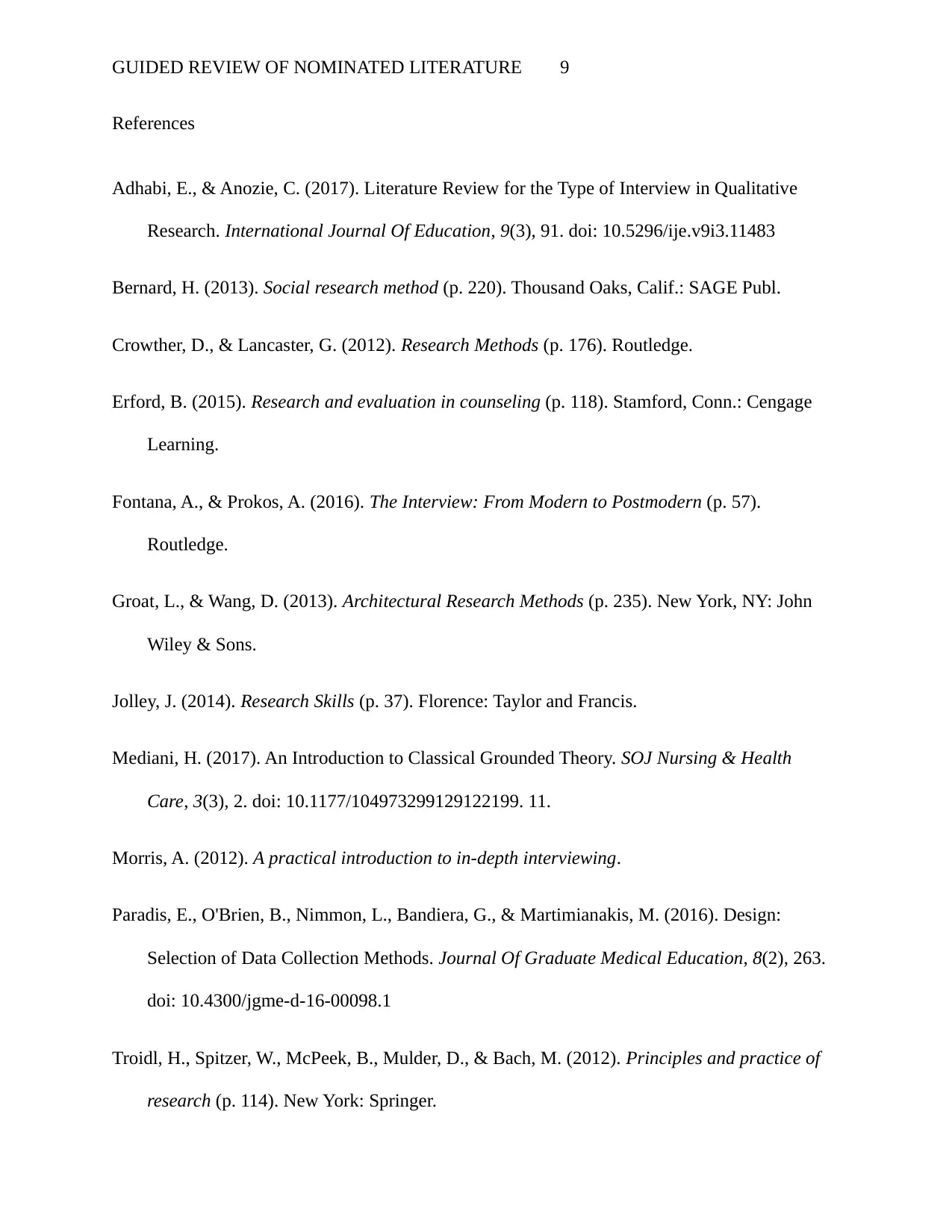
GUIDED REVIEW OF NOMINATED LITERATURE 9
References
Adhabi, E., & Anozie, C. (2017). Literature Review for the Type of Interview in Qualitative
Research. International Journal Of Education, 9(3), 91. doi: 10.5296/ije.v9i3.11483
Bernard, H. (2013). Social research method (p. 220). Thousand Oaks, Calif.: SAGE Publ.
Crowther, D., & Lancaster, G. (2012). Research Methods (p. 176). Routledge.
Erford, B. (2015). Research and evaluation in counseling (p. 118). Stamford, Conn.: Cengage
Learning.
Fontana, A., & Prokos, A. (2016). The Interview: From Modern to Postmodern (p. 57).
Routledge.
Groat, L., & Wang, D. (2013). Architectural Research Methods (p. 235). New York, NY: John
Wiley & Sons.
Jolley, J. (2014). Research Skills (p. 37). Florence: Taylor and Francis.
Mediani, H. (2017). An Introduction to Classical Grounded Theory. SOJ Nursing & Health
Care, 3(3), 2. doi: 10.1177/104973299129122199. 11.
Morris, A. (2012). A practical introduction to in-depth interviewing.
Paradis, E., O'Brien, B., Nimmon, L., Bandiera, G., & Martimianakis, M. (2016). Design:
Selection of Data Collection Methods. Journal Of Graduate Medical Education, 8(2), 263.
doi: 10.4300/jgme-d-16-00098.1
Troidl, H., Spitzer, W., McPeek, B., Mulder, D., & Bach, M. (2012). Principles and practice of
research (p. 114). New York: Springer.
References
Adhabi, E., & Anozie, C. (2017). Literature Review for the Type of Interview in Qualitative
Research. International Journal Of Education, 9(3), 91. doi: 10.5296/ije.v9i3.11483
Bernard, H. (2013). Social research method (p. 220). Thousand Oaks, Calif.: SAGE Publ.
Crowther, D., & Lancaster, G. (2012). Research Methods (p. 176). Routledge.
Erford, B. (2015). Research and evaluation in counseling (p. 118). Stamford, Conn.: Cengage
Learning.
Fontana, A., & Prokos, A. (2016). The Interview: From Modern to Postmodern (p. 57).
Routledge.
Groat, L., & Wang, D. (2013). Architectural Research Methods (p. 235). New York, NY: John
Wiley & Sons.
Jolley, J. (2014). Research Skills (p. 37). Florence: Taylor and Francis.
Mediani, H. (2017). An Introduction to Classical Grounded Theory. SOJ Nursing & Health
Care, 3(3), 2. doi: 10.1177/104973299129122199. 11.
Morris, A. (2012). A practical introduction to in-depth interviewing.
Paradis, E., O'Brien, B., Nimmon, L., Bandiera, G., & Martimianakis, M. (2016). Design:
Selection of Data Collection Methods. Journal Of Graduate Medical Education, 8(2), 263.
doi: 10.4300/jgme-d-16-00098.1
Troidl, H., Spitzer, W., McPeek, B., Mulder, D., & Bach, M. (2012). Principles and practice of
research (p. 114). New York: Springer.
⊘ This is a preview!⊘
Do you want full access?
Subscribe today to unlock all pages.

Trusted by 1+ million students worldwide

GUIDED REVIEW OF NOMINATED LITERATURE 10
Wu, Y., Thompson, D., Aroian, K., McQuaid, E., & Deatrick, J. (2016). Commentary: Writing
and Evaluating Qualitative Research Reports. Journal Of Pediatric Psychology, 41(5), 498.
doi: 10.1093/jpepsy/jsw032
Wu, Y., Thompson, D., Aroian, K., McQuaid, E., & Deatrick, J. (2016). Commentary: Writing
and Evaluating Qualitative Research Reports. Journal Of Pediatric Psychology, 41(5), 498.
doi: 10.1093/jpepsy/jsw032
1 out of 10
Related Documents
Your All-in-One AI-Powered Toolkit for Academic Success.
+13062052269
info@desklib.com
Available 24*7 on WhatsApp / Email
![[object Object]](/_next/static/media/star-bottom.7253800d.svg)
Unlock your academic potential
Copyright © 2020–2025 A2Z Services. All Rights Reserved. Developed and managed by ZUCOL.




